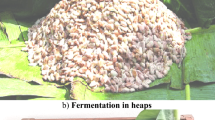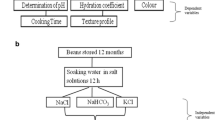Abstract
Koki is a nutritious cowpea-based food product usually processed by steam cooking whipped cowpea (Vigna unguiculata) paste mixed with spices and palm oil. A study was carried out to investigate the effect of the partial replacement of cowpeas (CP) with hard-to-cook (HTC) beans on the chemical, nutritional and sensory characteristics of koki. Towards this objective, two varieties of beans – Phaseolus vulgaris (red kidney beans – RKB and mottled brown beans – MBB), each with the HTC defect, were separately incorporated into cowpea paste in the following Bean:CP ratios 0:100, 20:80, 30:70, 40:60, 50:50, 60:40 and processed into koki. Incorporation of dry HTC beans into cowpeas in the making of koki affected the bulking properties of the uncooked paste, the nutrient composition, essential amino acid content, antinutritional factors, digestibility as well as the sensory attributes of cooked koki. Sensory tests showed that a highly acceptable, nutritious and digestible koki can be processed from cowpeas partially replaced with dry HTC bean paste up to levels of about 40–50% depending on the variety of dry bean used.
Similar content being viewed by others
References
Stanley DM (1992) Hard beans: A problem for growers, processors and consumes. Hort Technol 2: 370–378.
Hentges DL, Weaver CM, Nielson SS (1991) Changes of selected physical and chemical components in the development of the hard-to-cook bean defect. J Food Sci 56: 436–442.
Stanley DM, Aguilera JM (1985) A review of textural defects in cooked reconstituted legumes. The influence of structure and composition. J Food Biochem 9: 277–323
Mbofung CMF, Niba LL, Parker ML, Downie AJ, Rigby N, Leakey CLA, Waldron KW (1996) Development of hard-to-cook defect in horsehead beans: effect on some physical characteristics and on in vitro protein digestibility. In Fenwick GR, Hedley C, Richards RL, Khokhar S (eds), Agri-food Quality, an interdisciplinary approach. Royal Society of Chemistry. Cambridge UK, pp. 433–438.
Dolvo FE, Williams CE, Zoaka L (1976) Cowpea – Home preparation and use in West Africa. International Development Research Center, Ottawa, Canada.
Adeniji AO, Potter NN (1980) Production and quality of canned moinmoin. J Food Sc 45: 1359–1361.
Akinyele IO (1989) Effects of traditional methods of processing on the nutrient content and some anti-nutritional factors in cowpeas (Vigna unguiculata). Food Chem 33(4): 291–299.
Cherry JP, McWatters KH, Beuchat LR (1979) In Pour-El A (ed), Functionality and Protein Structure, ACS Symposium Series 92. Am Chem Society Washington, DC, pp. 1–26.
Pour-El, A (1981) In Protein Functionality in Foods, edited by JP Cherry. ACS Symposium Series 147. Am Chem Soc Washington, DC, pp. 1–19.
Onigbinde AO, Onobun V (1993) Effect of pH on some cooking properties of cowpea (Vigna unguiculata). Food Chem 47: 125–127.
AOAC (1990) Official Methods of Analysis, Association of Official Analytical Chemists, Washington, DC.
Prinyawiwatkul W, Watters KH, Beuchat LR, Phillips RD (1994) Physical properties of cowpea paste and akara as affected by supplementation with peanut flour. J Agric Food Chem 42: 1750–1756.
Elkin RG Wasynozuk (1987) Amino acid analysis of feed stuffs hydrolysates by precolumn derivatisation with phenylisothiocyanate and reversed phase high performance liquid chromatography. Cereal Chem 64(4): 226–229.
SPSS (1994) SPSS forWindows Professional Statistics Release 6.0 SPSS Inc Michigan, Chicago.
Statsoft (1995) Statistica for Windows Release 5. Tulsa Oklahoma USA.
Moneam NMA (1990) Effects of pre-soaking on faba enzyme inhibitors and polyphenols after cooking. J Agric Fd Chem 38: 1479–1482.
FAO/WHO/UNU (1985) Energy and Protein requirements. Report of a Joint FAO/WHO/UNU meeting Series N_ 724. WHO Geneva. Switzerland.
Martin-Cabrejas MA, Esteban RM, Waldron K, Maina G, Grant G, Barbocz S, Pusztai A (1995) Hard-to-cook phenomenon in beans: changes in anti-nutrient factors and nitrogenous compounds during storage. J Sci Food Agric 69: 429–435.
Cheftel JC, Cuq JL, Lorient D (1985) Amino acids, peptides and proteins. In Fennema OR (ed), Food chemistry, 32nd ed., Marcel Dekker, New York, pp. 245–369.
Tunkap TN, Mbofung CMF, Waldron KW (1996) Cowpea:HTC bean composite flour – Evaluation of functional and nutritional characteristics. In Fenwick GR, Hedley C, Richard RL, Khokhar S (eds), Agri-food Quality, an interdisciplinary approach. Royal Society of Chemistry, Cambridge, UK, pp. 429–432.
Deshpande SS, Rangnekar PD, Sathe SK, Salunke DK (1983) Functional properties of wheat-bean composite flours. J Food Sci 48: 1659–1662.
Snow P, O'dea K (1981) Factors affecting the rate of hydrolysis of starch in food. Am J Clin Nutri 34: 2721–2727.
Hernandex A, Jaffe WG (1968) Inhibitor de la amylase pancreatica en caraotas (Phaseolus vulgaris). Acta Cient Venez 19: 183–190.
Yu-Hui Tuan, Philips RD (1991) Effect of the Hard-to-Cook defect and processing on protein and starch digestibility of cowpeas. Cereal Chem 68(4): 413–418.
Sgarbieri VC (1989) Composition and nutritive value of beans. World Rev Nutr Diet 60: 132–198.
Phillips RD, Baker EA (1987) Protein nutritional quality of traditional and novel cowpea products measured by in vivo and in vitro methods. J Food Sci 52(3): 696–701.
Antunes PL, Sgarbieri VC (1980) Effect of heat treatment on the toxicity and nutritive value of bean (Phaseolus vulgaris var. Rosinha G2) proteins. J Agric Food Chem 28: 935–938.
Dryden MJ, Kendrick JG, Satterlee LD, Schroeder LJ, Block RG (1977) Predicting protein digestibility and quality, using an enzyme – Tetrahymena pyriformis W bioassay. J Food Biochem 1: 35–44.
Padma B, Sumathi S (1993) Effect of chemical treatments on tannins and in vitro protein digestibility of pigeon (Cajanus cajan) and common bean (Phaseolus vulgaris L.) Legume Research 16(1): 1–7.
Addy EOH, Salami LI, Iboeli LC, Remawa HS (1995) Effect of processing on nutrient composition and anti-nutritive substances of African locust bean (Parkia filicoidea) and baobab seed (Adansonia digitata). Plant Foods Hum Nutri 48(2): 113–117.
Savoi L, Parent G, Galibois I (1991) Effects of alkali treatment on the in-vitro digestibility of proteins and the release of amino acids. J Sci Food and Agric 56(3): 363–372.
Author information
Authors and Affiliations
Rights and permissions
About this article
Cite this article
Mbofung, C., Rigby, N. & Waldron, K. Use of two varieties of hard-to-cook beans (Phaseolus vulgaris) and cowpeas (Vigna unguiculata) in the processing of koki (a steamed legume product). Plant Foods Hum Nutr 54, 131–150 (1999). https://doi.org/10.1023/A:1008169000428
Issue Date:
DOI: https://doi.org/10.1023/A:1008169000428




